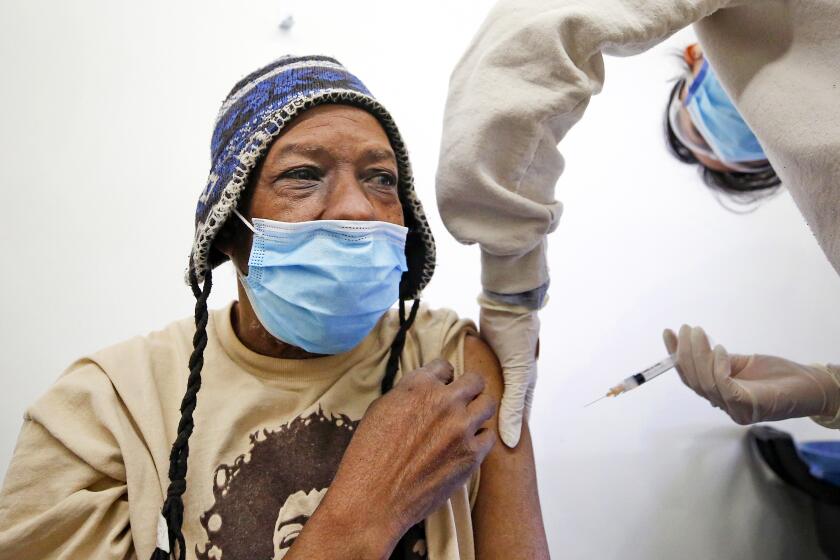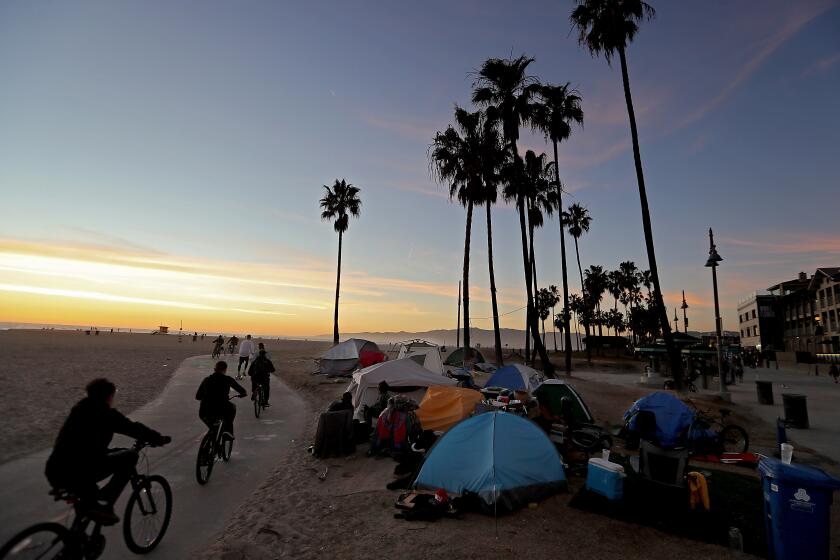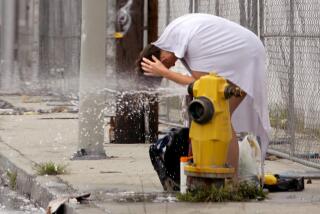L.A.’s homeless residents are 50% more likely to die if they get COVID. Now they’re a vaccine priority
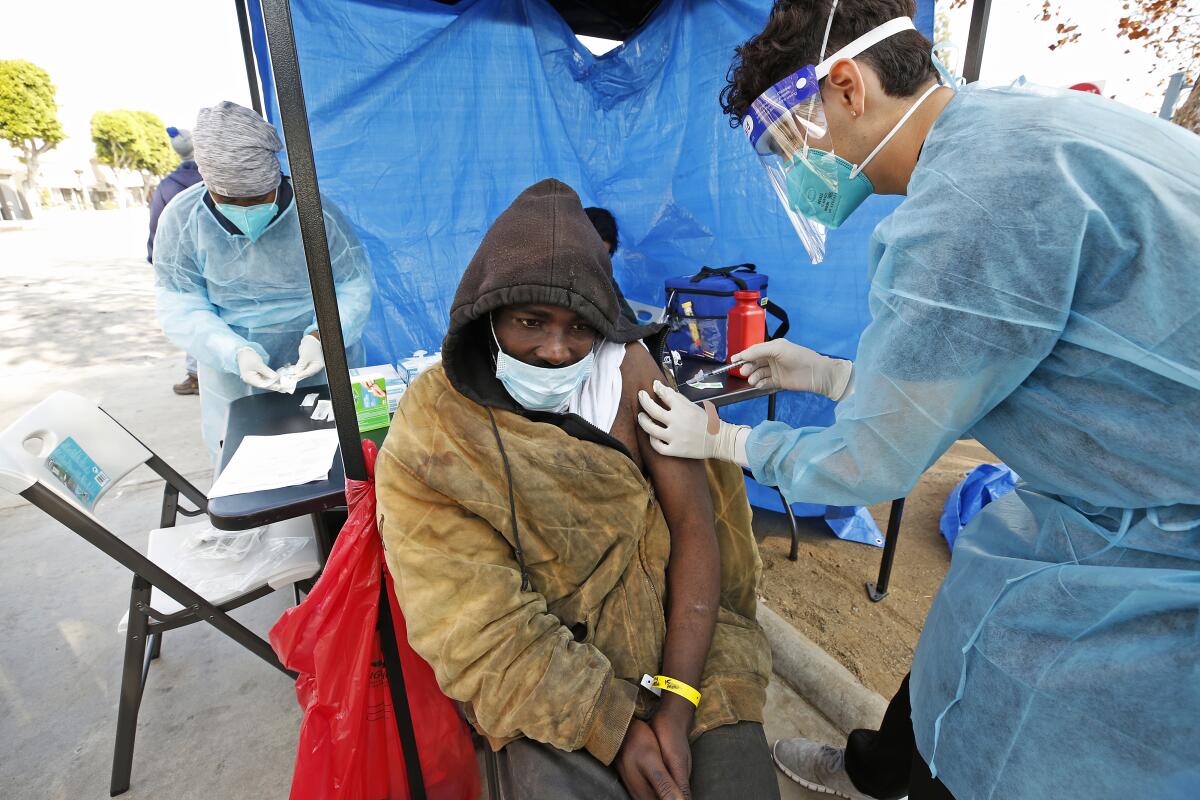
- Share via
Faced with the knowledge that homeless people are dying at much higher rates if they catch COVID-19, the Los Angeles County Department of Public Health will make the county’s entire homeless population eligible for vaccines starting Monday.
This comes as welcome news for public health officials and advocates who for months have been saying there should be more of a focus on a community that’s rife with comorbidities, struggles to access healthcare and can’t easily shelter in place or maintain social distance.
Earlier in the pandemic, researchers were surprised by the resilience of homeless people, who appeared to be contracting COVID at relatively low rates. But this week, new research from UCLA epidemiologists found that nationally, homeless people who did contract COVID-19 were 30% more likely to die than those in the general population. In Los Angeles County, homeless COVID-19 patients were 50% more likely to die.
Dr. Heidi Behforouz, medical director for L.A. County’s Housing for Health program, which has been running the homeless population vaccine rollout, said in an interview that she was excited about the change coming next week. She said the mortality statistics, while disturbing, were not surprising and bolstered the argument for vaccinating homeless people as soon as possible.
This change “allows us to vaccinate all people experiencing homelessness, because [the public health guidance] basically says anyone in shelter or potentially needing to go into shelter now qualifies,” she said. “If you think about the vaccine as a tool to help prevent severe illness and death, then you want to get it to people who are at higher risk of death.”
The effort to vaccinate L.A.’s most vulnerable and hard-to-reach homeless communities, which is just getting underway, is fraught with obstacles.
Until now, Behforouz’s teams have been limited not just by prioritization restrictions but also by the supply of vaccine they were receiving. Over the last six weeks, they have opened mobile clinics in hot spots around the county and vaccinated 3,300 people.
Their goal is to vaccinate 30,000 homeless people in the county by September. With the change in guidelines, she has requested 1,200 doses and a larger staff. Once her team grows, she will ask for 2,000 doses per week.
Kathryn M. Leifheit, a postdoctoral researcher at UCLA’s Fielding School of Public Health, was one of the lead authors of the new paper, which has not yet been peer reviewed. Still, she thought it was important to get the information out as soon as possible.
“I think we wanted it to be useful to policymakers, to the general public, to advocates, and we wrote it with that in mind,” Leifheit said in an interview.
The data analyzed by the UCLA team suggested that age is a major factor in the mortality differences. In Los Angeles, one of the few counties that provided age breakdowns, homeless people younger than 30 were nearly 14 times more likely to die if infected than their non-homeless peers. Homeless people in the 50-to-64 age group were two times more likely to die. Homeless people over 65 were less likely to die than those in the overall population.
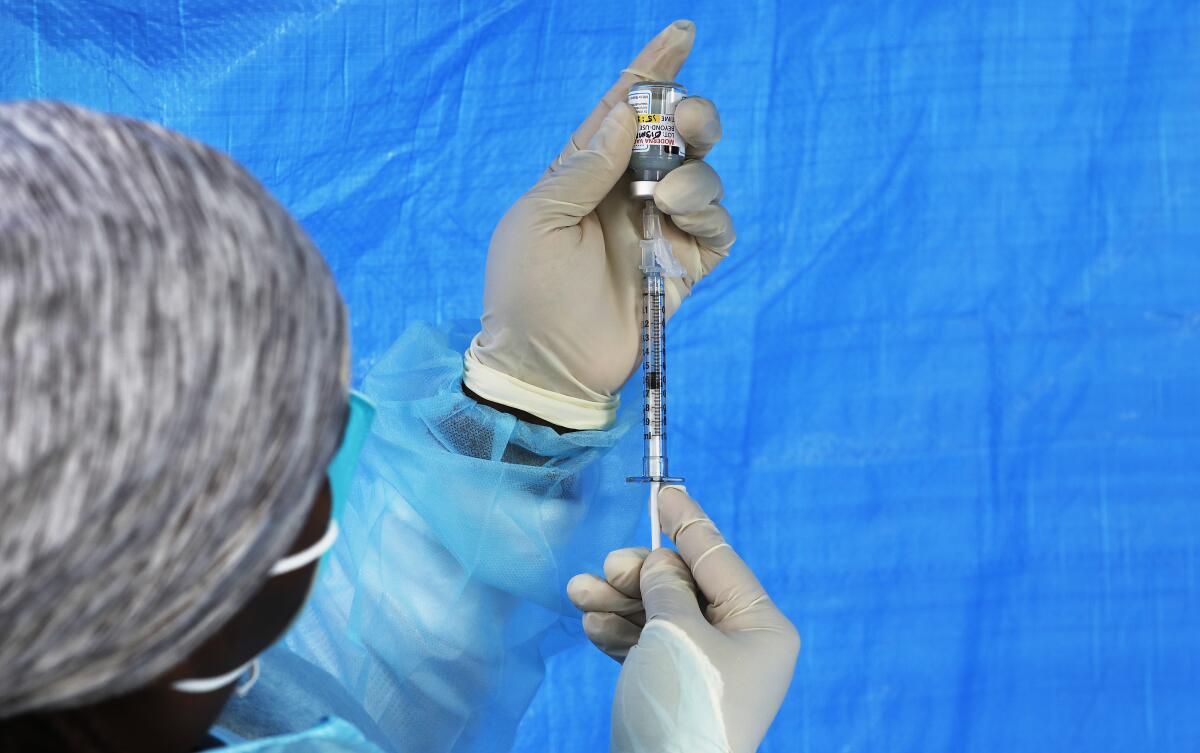
The authors speculated that homeless people who reach 65 may be less frail than members of that age group in general or that fewer people who are homeless live to the elevated ages — 80s and 90s — that are most vulnerable to COVID-19.
Leifheit said her hope is that the change in the guidelines will drive greater supply of vaccine to places that need it most, such as the mobile clinics Behforouz’s teams are running in poor communities that have large, unsheltered homeless populations.
In addition, she and her colleagues believe the broader eligibility for the vaccine will allow nurses and doctors to work more efficiently in the field. For example, when going into shelters, which have been hotbeds for infection, providers won’t have to do the hard work of identifying and documenting people who are over 65 or have preexisting conditions; instead, they can vaccinate everyone in the shelter.
Since the start of the pandemic, there have been just over 7,000 documented cases of COVID-19 in the Los Angeles homeless population, according to the Department of Public Health. At the outset of the pandemic, the city and county responded by renting thousands of hotel rooms for people at risk.
At the initiative’s peak over the summer, the city and county had 3,774 rooms under lease, but that number has decreased precipitously since then.
The COVID-19 pandemic has exacerbated the issue of homelessness in Southern California. We share images reminiscent of the Great Depression.
Fewer hotel rooms under contract and reduced capacity at shelters have meant more people are on the streets struggling to survive, said Mike Dickerson, co-chair of KTown for All, a volunteer homeless outreach group.
While he’s encouraged by the change in guidelines, he said the challenge will be getting the vaccine to people who can’t drive to a vaccination site such as Dodger Stadium and may not have access to the internet.
“For people who are living outside, it can be very difficult to make the kinds of adjustments that a lot of us have attempted to make to keep ourselves safe,” Dickerson said. “For unhoused people, that is just a very different prospect, and this news really offers an opportunity to engage with each other and be in community in public.”
More to Read
Sign up for Essential California
The most important California stories and recommendations in your inbox every morning.
You may occasionally receive promotional content from the Los Angeles Times.
